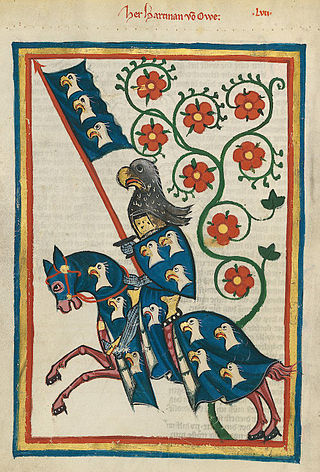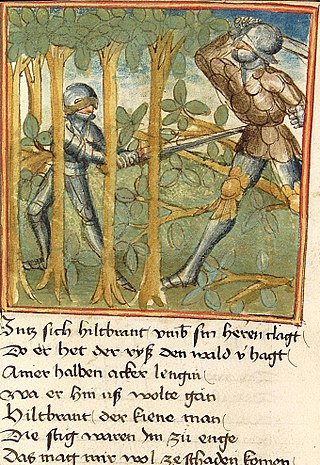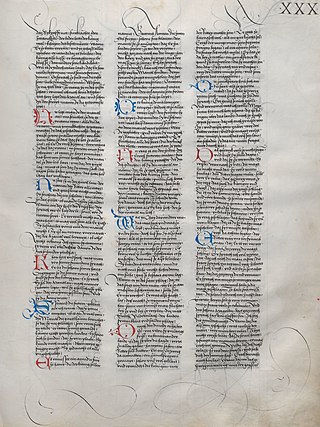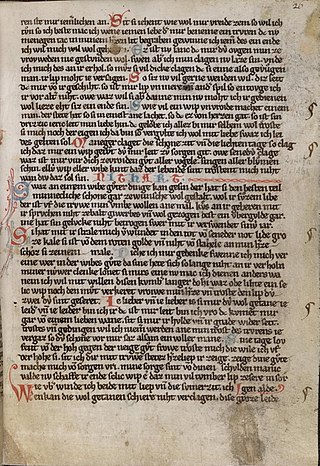
Hartmann von Aue, also known as Hartmann von Ouwe, was a German knight and poet. With his works including Erec, Iwein, Gregorius, and Der arme Heinrich, he introduced the Arthurian romance into German literature and, with Wolfram von Eschenbach and Gottfried von Strassburg, was one of the three great epic poets of Middle High German literature.

The Vienna Genesis, designated by siglum L (Ralphs), is an illuminated manuscript, probably produced in Syria in the first half of the 6th century. It is the oldest well-preserved, surviving, illustrated biblical codex.
Middle High German is the term for the form of German spoken in the High Middle Ages. It is conventionally dated between 1050 and 1350, developing from Old High German and into Early New High German. High German is defined as those varieties of German which were affected by the Second Sound Shift; the Middle Low German and Middle Dutch languages spoken to the North and North West, which did not participate in this sound change, are not part of MHG.

Heldenbücher is the conventional title under which a group of German manuscripts and prints of the 15th and 16th centuries has come down to us. Each Heldenbuch contains a collection of primarily epic poetry, typically including material from the Theodoric cycle, and the cycle of Hugdietrich, Wolfdietrich and Ortnit. The Heldenbuch texts are thus based on medieval German literature, but adapted to the tastes of the Renaissance.

Wolfdietrich is the eponymous protagonist of the Middle High German heroic epic Wolfdietrich. First written down in strophic form in around 1230 by an anonymous author, it survives in four main versions, widely differing in scope and content, and largely independent of each other.

Ortnit is the eponymous protagonist of the Middle High German heroic epic Ortnit. First written down in strophic form in around 1230 by an anonymous author, it circulated in a number of distinct versions.

Der Rosengarten zu Worms, sometimes called Der große Rosengarten to differentiate it from Der kleine Rosengarten (Laurin), and often simply called the Rosengarten, is an anonymous thirteenth-century Middle High German heroic poem in the cycle of Dietrich von Bern. The Rosengarten may have been written as early as before 1250, but is securely attested by around 1300. It is unclear where it was written.

Goldemar is a fragmentary thirteenth-century Middle High German poem by Albrecht von Kemenaten about the legendary hero Dietrich von Bern, the counterpart of the historical Ostrogothic king Theodoric the Great in Germanic heroic legend. It is one of the so-called fantastical (aventiurehaft) Dietrich poems, so called because it more closely resembles a courtly romance than a heroic epic.
Der arme Heinrich is a Middle High German narrative poem by Hartmann von Aue. It was probably written in the 1190s and was the second to last of Hartmann's four epic works. Combining courtly and religious narrative patterns, it tells the story of a noble knight who has been stricken by God with leprosy and can be cured only by the heart's blood of a virgin who willingly sacrifices herself for his salvation.

Iwein is a Middle High German verse romance by the poet Hartmann von Aue, written around 1200. An Arthurian tale freely adapted from Chrétien de Troyes' Old French Yvain, the Knight of the Lion, it tells the story of Iwein (Yvain), a knight of King Arthur's Round Table. It was written after Hartmann's Erec, and is generally taken to be his last work.

Dietrich von Bern is the name of a character in Germanic heroic legend who originated as a legendary version of the Ostrogothic king Theodoric the Great. The name "Dietrich", meaning "Ruler of the People", is a form of the Germanic name "Theodoric". In the legends, Dietrich is a king ruling from Verona (Bern) who was forced into exile with the Huns under Etzel by his evil uncle Ermenrich. The differences between the known life of Theodoric and the picture of Dietrich in the surviving legends are usually attributed to a long-standing oral tradition that continued into the sixteenth century. Most notably, Theodoric was an invader rather than the rightful king of Italy and was born shortly after the death of Attila and a hundred years after the death of the historical Gothic king Ermanaric. Differences between Dietrich and Theodoric were already noted in the Early Middle Ages and led to a long-standing criticism of the oral tradition as false.

Sigenot is an anonymous Middle High German poem about the legendary hero Dietrich von Bern, the counterpart of the historical Ostrogothic king Theodoric the Great in Germanic heroic legend. It is one of the so-called fantastical (aventiurehaft) Dietrich poems, so called because it more closely resembles a courtly romance than a heroic epic. It was likely written in the Alemannic dialect area, no later than 1300.

Laurin or Der kleine Rosengarten is an anonymous Middle High German poem about the legendary hero Dietrich von Bern, the counterpart of the historical Ostrogothic king Theodoric the Great in Germanic heroic legend. It is one of the so-called fantastical (aventiurehaft) Dietrich poems, so called because it more closely resembles a courtly romance than a heroic epic. It likely originates from the region of South Tyrol, possibly as early as 1230, though all manuscripts are later.

Virginal, also known as Dietrichs erste Ausfahrt, or Dietrich und seine Gesellen is an anonymous Middle High German poem about the legendary hero Dietrich von Bern, the counterpart of the historical Ostrogothic king Theodoric the Great in Germanic heroic legend. It is one of the so-called fantastical (aventiurehaft) Dietrich poems, so called because it more closely resembles a courtly romance than a heroic epic. The poem was composed by 1300 at the latest, and may have been composed as early as the second quarter of the thirteenth century.
Middle High German literature refers to literature written in German between the middle of the 11th century and the middle of the 14th. In the second half of the 12th century, there was a sudden intensification of activity, leading to a 60-year "golden age" of medieval German literature referred to as the mittelhochdeutsche Blütezeit. This was the period of the blossoming of Minnesang, MHG lyric poetry, initially influenced by the French and Provençal tradition of courtly love song. The same sixty years saw the composition of the most important courtly romances. again drawing on French models such as Chrétien de Troyes, many of them relating Arthurian material. The third literary movement of these years was a new revamping of the heroic tradition, in which the ancient Germanic oral tradition can still be discerned, but tamed and Christianized and adapted for the court.

Erec is a Middle High German poem written in rhyming couplets by Hartmann von Aue. It is thought to be the earliest of Hartmann's narrative works and dates from around 1185. An adaptation of Chrétien de Troyes' Erec et Enide, it is the first Arthurian Romance in German.

The Kleine Heidelberger Liederhandschift is a collection of Middle High German Minnesang texts. In Minnesang scholarship it is referred to as MS. A. It is held by the Heidelberg University Library with the signature Cod.Pal.germ. 357.

Dietrichs Flucht or Das Buch von Bern is an anonymous 13th-century Middle High German poem about the legendary hero Dietrich von Bern, the legendary counterpart of the historical Ostrogothic king Theodoric the Great in Germanic heroic legend. It is part of the so-called "historical" Dietrich material and is closely related to, and always transmitted together with, a second Dietrich poem, the Rabenschlacht. A Heinrich der Vogler is named as author in an excursus of the poem. Earlier scholarship considered him to be the author of Dietrichs Flucht and possibly also of the Rabenschlacht, however more recent scholarship believes he is only author of this excursus.

Die Rabenschlacht is an anonymous 13th-century Middle High German poem about the hero Dietrich von Bern, the counterpart of the historical Ostrogothic king Theodoric the Great in Germanic heroic legend. It is part of the so-called "historical" Dietrich material and is closely related to, and always transmitted together with, a second Dietrich poem, Dietrichs Flucht. At one time, both poems were thought to have the same author, possibly a certain Heinrich der Vogler, but stylistic differences have led more recent scholarship to abandon this idea.
Dietrich und Wenezlan is a fragmentary Middle High German poem about the legendary hero Dietrich von Bern, the counterpart of the historical Ostrogothic king Theodoric the Great in Germanic heroic legend. It usually considered part of the so-called "historical" Dietrich material, as it appears to cite Dietrich's exile at the court of Etzel described in the "historical poems" Dietrichs Flucht and the Rabenschlacht. The fragment of about 500 lines tells of Dietrich's challenge by Wenezlan of Poland, who has captured one of Dietrich's warriors. It is unclear whether the fragment was the main focus of a poem or a single episode from a longer poem.


















